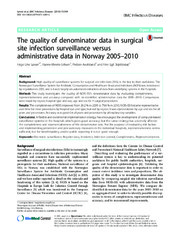| dc.contributor.author | Løwer, Hege Line Magnussen | |
| dc.contributor.author | Eriksen, Hanne-Merete | |
| dc.contributor.author | Aavitsland, Preben | |
| dc.contributor.author | Skjeldestad, Finn Egil | |
| dc.date.accessioned | 2016-03-10T10:43:56Z | |
| dc.date.available | 2016-03-10T10:43:56Z | |
| dc.date.issued | 2015-11-30 | |
| dc.description.abstract | Background: High quality of surveillance systems for surgical site infections (SSIs) is the key to their usefulness. The
Norwegian Surveillance System for Antibiotic Consumption and Healthcare-Associated Infections (NOIS) was introduced
by regulation in 2005, and is based largely on automated extraction of data from underlying systems in the hospitals.
<p>Methods: This study investigates the quality of NOIS-SSI’s denominator data by evaluating completeness,
representativeness and accuracy compared with de-identified administrative data for 2005–2010. Comparisons
were made by region, hospital type and size, age and sex for 4 surgical procedures.
<p>Results: The completeness of NOIS improved from 29.2 % in 2005 to 79.8 % in 2010. NOIS-SSI became representative
over time for most procedures by hospital size and type, but not by region. It was representative by age and sex for all
years and procedures. Accuracy was good for all years and procedures by all explanatory variables.
<p>Conclusions: A flexible and incremental implementation strategy has encouraged the development of computer-based
surveillance systems in the hospitals which gives good accuracy, but the same strategy has adversely affected
the completeness and representativeness of the denominator data. For the purpose of evaluating risk factors
and implementing prevention and precautionary measures in the individual hospitals, representativeness seems
sufficient, but for benchmarking and/or public reporting it is not good enough. | en_US |
| dc.description | Published version, also available at <a href=http://dx.doi.org/10.1186/s12879-015-1289-x>http://dx.doi.org/10.1186/s12879-015-1289-x</a> | en_US |
| dc.identifier.citation | BMC Infectious Diseases (2015) 15:549 | en_US |
| dc.identifier.cristinID | FRIDAID 1320226 | |
| dc.identifier.doi | 10.1186/s12879-015-1289-x | |
| dc.identifier.issn | 1471-2334 | |
| dc.identifier.uri | https://hdl.handle.net/10037/8836 | |
| dc.identifier.urn | URN:NBN:no-uit_munin_8395 | |
| dc.language.iso | eng | en_US |
| dc.publisher | BioMed Central | en_US |
| dc.relation.uri | http://www.ncbi.nlm.nih.gov/pmc/articles/PMC4666046/pdf/12879_2015_Article_1289.pdf | en_US |
| dc.rights.accessRights | openAccess | |
| dc.subject | VDP::Medisinske Fag: 700::Klinisk medisinske fag: 750::Infeksjonsmedisin: 776 | en_US |
| dc.subject | VDP::Medical disciplines: 700::Clinical medical disciplines: 750::Communicable diseases: 776 | en_US |
| dc.subject | Electronic surveillance | en_US |
| dc.subject | Register data | en_US |
| dc.subject | Incidence | en_US |
| dc.subject | Infection control | en_US |
| dc.subject | Completeness | en_US |
| dc.subject | Representativeness | en_US |
| dc.title | The quality of denominator data in surgical site infection surveillance versus administrative data in Norway 2005-2010 | en_US |
| dc.type | Journal article | en_US |
| dc.type | Tidsskriftartikkel | en_US |
| dc.type | Peer reviewed | en_US |


 English
English norsk
norsk